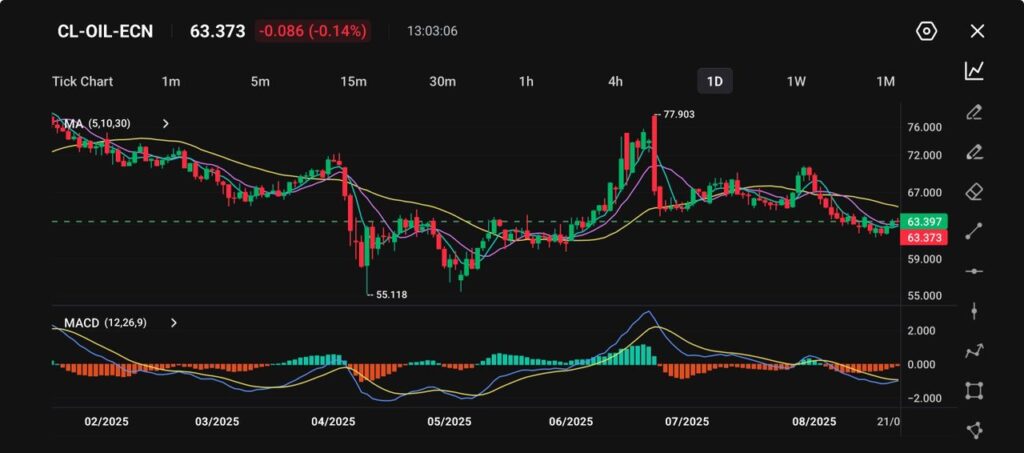
Crude oil remains at the centre of global market attention as shifting geopolitics and uncertain peace talks continue to shape investor sentiment. With supply risks, sanctions, and policy decisions all in play, traders are watching closely to see whether oil can stabilise or if fresh volatility lies ahead.
Cease-fire uncertainty underpins crude oil prices
Crude oil prices strengthened on Friday as hopes for a quick resolution to the Russia–Ukraine conflict began to fade. Brent crude rose to $67.85 per barrel, while WTI crude climbed to $63.74, leaving both benchmarks on track to end the week in positive territory.
Our research desk notes that optimism around peace talks has cooled, with efforts to arrange a summit between Presidents Putin and Zelensky facing continued obstacles.
Disagreements over Ukraine’s future security guarantees remain a sticking point, with Moscow pushing for influence over any defence framework. The stalling negotiations have revived concerns about tougher sanctions on Russia, which could tighten supply conditions and provide further support to oil prices.
Technical analysis
The crude oil market has displayed wide swings throughout 2025, ranging from April’s trough at $55.11 to July’s rally peak near $77.90. After a strong mid-year surge, momentum has cooled, and prices are now attempting to stabilise around the $63 level.
Short- and medium-term moving averages (5, 10, 30) still reflect a bearish structure after recent declines. However, the flattening of shorter-term averages suggests that downward momentum may be losing strength.

Picture: Crude oil trades near $63.37, stabilising after recent declines with support emerging above $60 and a flattening MACD signal, as shown on the VT Markets app.
The MACD, which remains below the zero line, continues to show weak momentum but offers early signs of a base forming as the histogram narrows.
In the near term, resistance is expected around $66–67, aligned with recent swing highs and clustered moving averages. A breakout above this level could trigger a retest of $70 or higher.
On the downside, immediate support stands at $60, with stronger protection near April’s low of $55. As long as prices hold above $60, crude may be carving out a consolidation zone. A break below, however, would increase the risk of a deeper retracement.
Overall, crude oil remains in a watchful consolidation phase, with traders closely tracking US inventory reports, OPEC decisions, and demand trends in key economies for the next major directional cue.
Cautious forecast
Looking ahead, crude oil prices are likely to remain highly sensitive to geopolitical developments. If Russia–Ukraine talks continue to falter, WTI crude could retest the $67.00–$70.00 zone, with supply concerns keeping an upward bias intact.
That said, a breakthrough in negotiations would likely deflate the current risk premium, potentially dragging prices back toward the $60.00 support area. Traders should also be mindful of secondary drivers such as Chinese demand recovery, seasonal refinery activity, and currency fluctuations, all of which could amplify volatility.
While the broader trend remains cautious, the market’s underlying risk profile leans to the upside in the near term. Any escalation in geopolitical tensions or disruption to supply chains would likely act as a strong catalyst for higher oil prices, reinforcing the need for close monitoring of global events.
Click here to open account and start trading.





